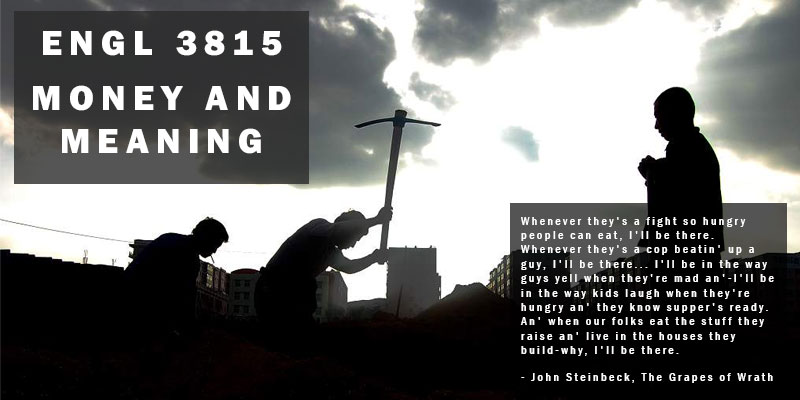Catalog Description: Prerequisites: Completion of Blocks A and B4, an additional course from Block B, and at least one course each from Blocks C and D. Study of literary works devoted to economic themes; texts are drawn from various periods and contexts. UD GE C (cl)
Course Description: This course introduces general education students to the relationships between economics and literature and to the broad diversity of ways that economic themes have been represented in literary works drawn from various historical and geographical contexts. Students will develop skills as critical readers of literature while exploring texts that thematize production, exchange, circulation, greed, and debt. Through this framework, students will gain insight into the ways that literature has consistently served as a privileged site for complex debates over the ethics of business, the social role of money and ambition, and the dynamics of class difference. The course furthermore explores the economics of literature, exploring the functioning of the literary marketplace, the relationship between literary value and economic value, and the role of the literary artist within both capitalist and non-capitalist societies.
English 3815 includes a community engagement and civic learning component. As defined by the Association of American Colleges and Universities, civic engagement within the academic context involves “working to make a difference in the civic life of our communities and developing the combination of knowledge, skills, values and motivation to make that difference. It means promoting the quality of life in a community, through both political and non-political processes.” Students will be introduced to the basic premises of social entrepreneurship and will be encouraged to identify social issues of particular interest to them, to use the principles of entrepreneurship to imagine solutions and prospects for social change, and to measure the performance of literary characters by this ethical standard. Furthermore, students will be encouraged to use their skills as critical readers, writers, and entrepreneurs to devise ways of raising campus consciousness about student debt and the need for college students – a highly financially vulnerable population, and in fact the second most vulnerable to bankruptcy in our society – to cultivate financial literacy.
Learning Outcomes
Upon completion of this course, students will be able to:
- demonstrate familiarity with primary conventions in literary representations of economic themes
- recognize the political, psychological, ethical, and ideological stakes of such representations
- assess differences between different genres and forms of writing, as well as between works from different periods and contexts
- apply tools of critical thinking and cultural and literary analysis to textual materials from various historical and cultural contexts
- demonstrate the ability to present questions and ideas in both written and verbal form, and to respond to the ideas of others in discussions
Upon completion of the community engagement and civic learning component, students will be able to:
- employ techniques for translating disciplinary knowledge into civic participation and agency within communities
- effectively collaborate with, and communicate to, others as a means of intervening in a civic issue having to do with economics
- understand the reciprocal impact of students on their environment and vice versa
Course Outline
The course content will vary depending on the faculty member teaching it. One possibility follows:
Money and Meaning in American Literature
Part I. Puritan Values: Heroic entrepreneurship and conquest; domestic economy (Bradstreet or Rowlandson)
Part II. The Work Ethic (Franklin, Irving); CL component: First financial literacy training: work
Part III. Industrialization (Melville, Davis)
Part IV. Finance: Dreiser’s Cowperwood novels in context; CL component: Second financial literacy training: debt
Part V. Class (Fitzgerald and Donato); CL component: Third financial literacy training
Part VI. Mobility and Precarity (Steinbeck, Dos Passos)
Part VII. Mass Culture (West, Fearing); CL symposia and workshops for dissemination
Part VIII. Contemporary Bubbles and Burstings (Lipsyte)
About the Banner: Migrant workers in China work on a building foundation (image from http://upload.wikimedia.org/wikipedia/commons/a/ae/Migrant_worker_of_china.jpg)
